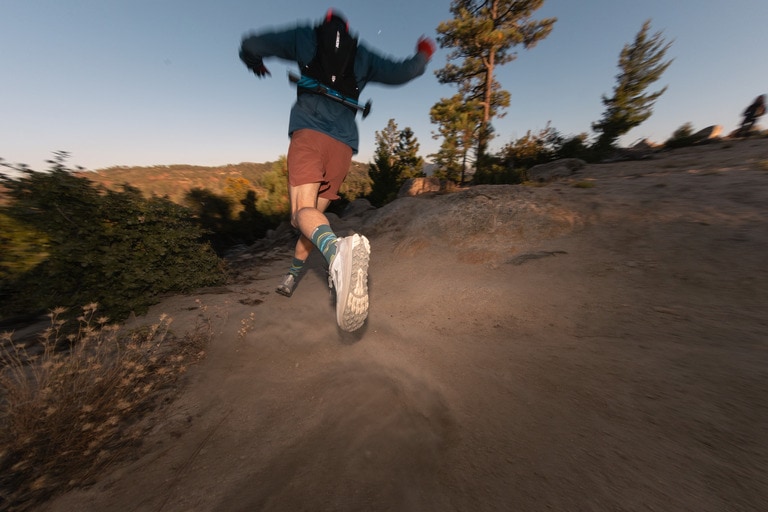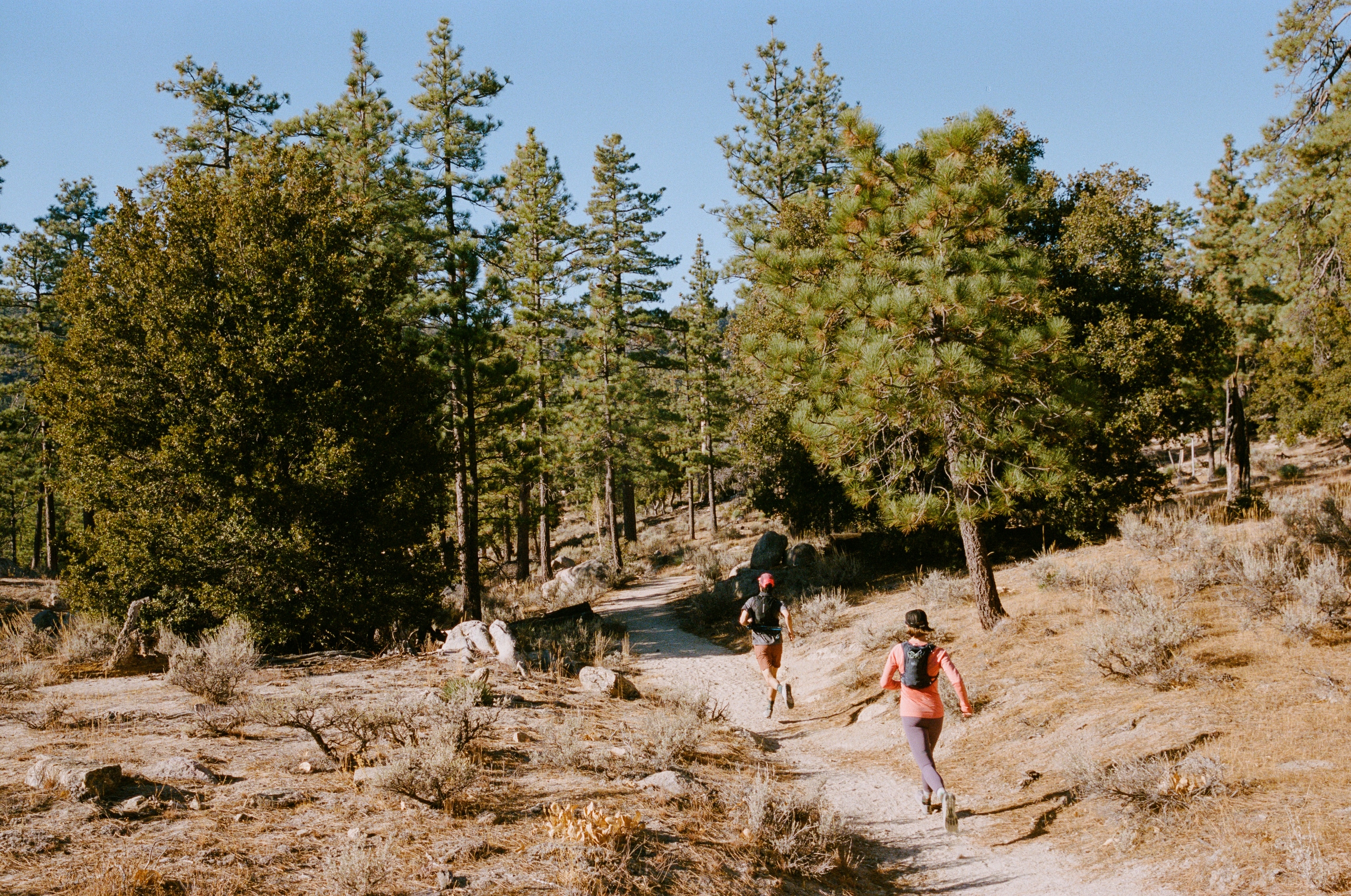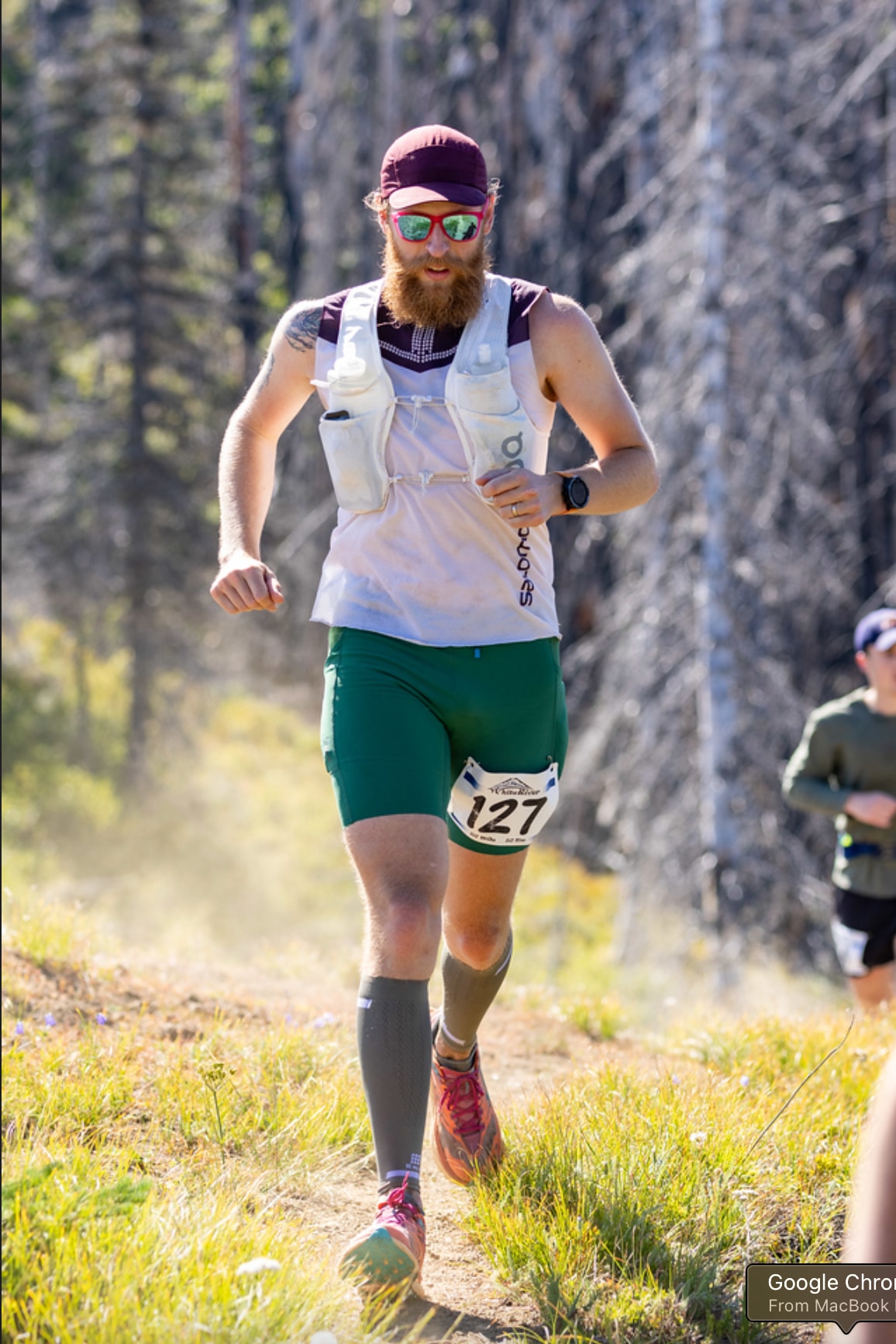From pensive loops at your local park to awestruck miles above treeline, spending time running on a trail is good for the soul. Whether you’re a road runner looking to expand your horizons, a hiker itching to speed things up or simply new to running in general, we offer a warning: Once you start trail running, you may never want to stop.
Some standard running gear (like what you’ll find in our Essential Running Gear Checklist) can help you get started trail running, especially on light, manicured and easily accessible trails—like in city parks or on rail-trails that run alongside bike paths. However, when it comes to rugged or technical terrain, long trail runs (anything lasting more than an hour) or backcountry trail runs, certain trail-specific options will go a long way toward smoothing your path.
Trail-Running Essentials
For quick recommendations, click below, or keep scrolling for more information.
- Trail-running shoes
- Hydration vest
- Sunglasses
- Hat
- Jacket
- Communication device
- Fuel
- First-aid supplies
- Emergency shelter
- Headlamp
Other trail-running gear (apparel, watches and more)

1. Trail-running shoes
If you’re just dipping a toe into trail running by heading out on groomed trails, a pair of road-running shoes should suffice. Once you’re ready to take the plunge into more rugged terrain, however, using trail-specific running shoes becomes key. The biggest difference between trail- and road-running shoes is the outsole, which provides extra grip and protection on loose and technical surfaces. As with any pair of running shoes, the most important thing is to find a shoe that feels good for your feet, so head to your local REI to get your feet measured and test out a few pairs. To learn more about picking the perfect trail-running shoes, read How to Choose Trail-Running Shoes.
Trail-Running Zero Drop Shoes
Altra Lone Peak 9 Trail-Running Shoes
Cushioning Moderate
Heel-to-toe drop (mm) 0
Weight (pair) 1 lb 3 oz. (women's), 1 lb. 6.4 oz. (men's)
The Lone Peak 9 trail-running shoes from Altra can handle whatever the trail has to offer, from long technical trails to quick miles at the local park. The outsole's deep lugs and sticky rubber offer maximum traction on everything from packed dirt to rocky, rooty trails to mud; the midsole incorporates a rock plate to help stabilize and protect your feet when the going gets rough; and the upper features extra wiggle room in the toe box to keep your little piggies comfortable over the long run. Buy women’s and men’s.
Multi-Terrain Trail-Running Shoes
norda 001 Trail-Running Shoes
Cushioning Maximum
Heel-to-toe drop (mm) 5
Weight (pair) 1 lb. 0.3 oz. (women's); 1 lb. 3 oz. (men's)
The 001 from norda is designed to last, using highly durable materials from the outsole all the way to the laces. With plenty of lightweight cushioning to keep you protected from the trail, aggressive lugs for traction on any surface and an innovative upper design that provides a secure fit, the 001s should be able to handle whatever terrain you throw at them. Buy men's and women's.
Shop expert-recommended trail-running shoes: Best Trail-Running Shoes: Tested | Best Running Shoes for Racing: Staff Picks
2. Hydration vest
While handheld water bottles and waistbelts are great options for carrying a bit of extra water and a gel or two, a hydration vest and its larger carrying capacity is a must-have for trail runners who may need to have essentials along, like emergency supplies, extra food and additional layers. The best hydration vest will be comfortably snug to minimize irritating bounciness and have easy-to-reach pockets to keep your most-used items close. There are plenty of features and styles to choose from, so your best bet is to read How to Choose a Running Hydration Vest before heading to an REI store to try them yourself.
Trail-Running Hydration Vest
Salomon Adv Skin 12 Hydration Vest
Gear capacity (L) 12 liters
Liquid capacity (L) 1 liter
Reservoir compatible Yes
Bottle(s) included 2 bottles
Weight 8.7 ounces
From comfort to capacity to usability, the Adv Skin 12 Hydration Vest from Salomon checks all the boxes. With a generous yet snug wraparound fit, the vest feels more like a piece of apparel than a pack and, thanks to several well-placed pockets, your fuel, phone and other essentials are always nearby. Stretchy-but-sturdy fabric means plenty of room to carry extra layers and gear in the rear zippered compartment while keeping everything compressed to minimize bounce. The vest comes with two 500 ml soft flasks in the front pockets, and there’s a slot for a hydration reservoir. Buy here.
3. Sunglasses
Even on cloudy days, a pair of sunglasses on your trail runs is a must. Beyond shading your eyes from sun and glare, sunglasses provide protection from windblown debris, dust and even rain. Finding a good fit is nonnegotiable, and you’d also do well to look for features like antifog coatings to keep your vision clear and polarization to cut down on glare. Read How to Choose Sunglasses for more advice.
goodr Wrap G Sunglasses
Lens material TAC
Frame material Nylon
Bridge fit Adjustable bridge
Polarized Yes
A great pair of sunglasses blends form and function, and the Wrap G Sunglasses from goodr is a perfect example. The polarized, wraparound lens provides shade from every angle, and they come with a removable nosepiece to help dial in the fit. The sunglasses feature antifog and anti-glare coatings, and at just $35, it’s hard to beat the price. Buy here.
4. Hat
It may sound incredible, but hats are second only to shoes on many runners’ lists of essential trail-running gear. Like sunglasses, they keep glare, rain and sweat out of your eyes, and they also help to keep you cool in the summer and warm in the winter. Running hats should be lightweight, breathable, wicking and quick-drying. And a good fit is essential, so look for adjustability features.
Essential Trail-Running Hat
Janji AFO Hyperlight Cap
Fabric 88% recycled polyester/12% elastane
Head circumference 23 (adjustable) inches
UPF rating 25
Weighing in at just an ounce, made of soft, quick-drying material and featuring an easily customizable fit, the AFO Hyperlight Cap from Janji nearly disappears on your head. The crushable cap can be stowed in a pocket without losing its shape, and several REI customer-reviewers appreciate how easy it is to wash, though air drying is recommended. Buy here.
5. Jacket
When trail running in cool weather or light rain, a running jacket can make the difference between a great run and a slog. Depending on the weather, you might prefer your jacket to be thin, breathable and packable for easy stowage, or to have some extra insulation for particularly cold days. Wind resistance and a durable water repellent (DWR) coating to keep you cozy and dry are must-haves for any running jacket. Avoid completely waterproof jackets for all but the most intense conditions—these fabrics trap sweat, potentially leaving you just as soggy inside the jacket as out. Read How to Choose Rainwear for more tips.
Essential Trail-Running Jacket
REI Co-op Swiftland Insulated Running Jacket
Fabric 63% recycled polyester/28% LanzaTech polyester/9% spandex (bluesign approved) in lower front torso and back ; 100% nylon (bluesign approved) in upper torso and shoulders.
Insulation 40 g 50% recycled polyester/50% polyester (bluesign approved)
Weight 9.9 ounces (women's), 11.3 ounces (men's)
Thumbholes Yes
The Swiftland Insulated Running Jacket from REI Co-op is the perfect piece for those days when hiding under layers of blankets feels more appealing than heading out for a run. With thin insulation in the chest and shoulders for warmth without extra bulk, and breathable fleece in the back and on the lower front, the jacket is designed to keep you cozy without overheating. It also features a DWR coating on key areas to help moisture bead up, fold-over cuff mitts and thumb holes to keep your hands toasty, and zippered pockets for securing small essentials. Buy women’s and men’s.
Shop more running jackets: When the weather turns warmer and you just need a thin layer to shed wind and light rain, the Houdini Jacket from Patagonia is a great option. Weighing in at less than 3.5 ounces and packing into its own pocket for easy stowage, the Houdini is the definition of everything you need and nothing you don’t. Buy women’s and men’s.
6. Communication device
When your trail running takes you away from civilization, carrying a means of communication is more than just a good idea—it’s an essential. Many popular trail-running areas have reliable cell coverage, making your phone a good option, but for those adventures that take you deep into the backcountry, a satellite communicator or personal locator beacon is a better and more dependable choice. To learn about the differences between the two, and which might be best for your needs, read How to Choose Between a PLB and a Satellite Messenger.
Garmin inReach Mini 2
Dimensions 3.9 x 2 x 1 inches
Weight 3.5 ounces
GPS/Satellite detectable Yes
Messaging capability 2-Way messaging
Battery life Up to 14 days (10-minute tracking, standard activity in default mode); up to 5 days (10-minute tracking, high detail activity); up to 30 days (30-minute tracking interval, standard activity)
When you stash the inReach Mini 2 from Garmin in your running vest, you’re carrying a little peace of mind into the wilderness—for you and your loved ones. The inReach uses satellites to send and receive messages, allowing you to stay in touch with friends and family even in areas without cell coverage. It features a generous 14 days of battery life in default mode, an SOS button that connects you with search and rescue teams in case of emergency, and the ability to share your location with chosen contacts as you go. The Garmin app lets you connect your device and phone to make sending and receiving messages as simple as texting; it also includes mapping software, essentially turning your phone into a GPS device. (A subscription is required to use the two-way communication features.) Buy here.
7. Fuel
Keeping your energy up during a run is always a good idea but when you’re out for an hour-plus adventure on trails, it becomes essential. There are a lot of snack choices out there—from running-specific gels and gummies to meal bars and bags of potato chips—and even more information on how best to balance your carb, protein and fat intake. As usual, the best way to find what works best for you and your body is to test a variety of options during your runs. Read our articles on Runners’ Nutrition Basics and What to Eat to Fuel Your (Long) Run to learn more.

PROBAR Meal Bar
Calories per serving 350 - 390
Total fat 17 - 20 grams
Sodium 30 - 90 milligrams
Carbohydrates 46 - 49 grams
Protein 8 - 9 grams
While gels, gummies and drink mixes are a useful, efficient way of getting quick-burning carbs into your system, sometimes your body craves real food, especially after a couple hours on the trail. Enter the PROBAR Meal Bar. Made with organic, natural ingredients, and with a nutritional balance that provides slow-burning energy for the long haul, the Meal Bar makes for a perfect trailside or summit snack on high-mileage days. And with flavors like s’mores, peanut butter chocolate chip and superfood slam (my personal favorite), your taste buds will join the rest of your body in appreciating the break from more processed running foods. Buy here.
8. First-aid supplies
On runs that take you away from civilization, carrying a first-aid kit—as well as knowledge about using it—will enable you to treat minor issues so they don’t become major. Your kit’s size and contents depend on variables like the climate and terrain, how long you plan to be out, and any specific medical needs you may have. For a comprehensive list of first-aid supplies, read our First-Aid Kit Checklist, and to learn more read How to Choose First-Aid Kits.
Trail-Running First Aid

Adventure Medical Kits Ultralight/Watertight .3 Medical Kit
Dimensions 5.5 x 5.25 x 1.75 inches
Weight 2.6 ounces
With the Ultralight/Watertight .3 Medical Kit from Adventure Medical Kits, you can hit the trail with confidence and without having to carry a bulky first-aid kit. The package has enough supplies to treat common minor injuries—blisters, cuts and scrapes, splinters, rolled ankles, and more—and it’s all contained in a small, waterproof storage bag. There’s also enough room for your personal medication. If you want to carry more than just the basics, or if you’re supplying a group of runners, the .5, .7 and .9 Medical Kits contain additional supplies while keeping the overall package small, light and waterproof. Buy here.
9. Emergency shelter
Unlike traditional shelters like a tent or bivy, emergency shelters take up minimal space and weigh next to nothing—but their value far exceeds their footprint in your vest. Even the best laid trail-running plans can’t accommodate every eventuality, and if you’re forced to spend an unforeseen night outside, you’ll be glad you carried an emergency shelter. Options range from simple heat-reflective blankets to waterproof bivies that can fit a sleeping bag.
SOL Emergency Blanket
Dimensions 84 x 56 inches
Weight 2.5 ounces
Material(s) Plastic
There’s no reason not to carry the Emergency Blanket from SOL on all your trail runs: It weighs 2.5 ounces and packs down smaller than most paperback books. The blanket provides protection from wind and moisture while reflecting up to 90% of your body’s heat back to you, and the bright orange exterior is easy to spot. At only $5.50, you won’t regret adding it to your trail-running kit, but you might regret passing it up. Buy here.
10. Headlamp
Even if your runs are scheduled during daylight hours, carrying a headlamp is always a good idea when you leave paved paths. What separates a decent running headlamp from a great one are brightness, usability and fit. It’s essential to find a model that doesn’t bounce on your forehead as you move—nothing is more annoying than a jostling headlamp. Learn more with our How to Choose Headlamps guide.
Black Diamond Distance 1500 Headlamp
Light output 1,500 lumens on high with boost; 800 lumens on high; 300 lumens on medium; 15 lumens on low
Beam distance 117 on high with boost; 95 meters on high; 45 meters on medium; 5 meters on low
Average run time 100 minutes on high; 6 hours on medium; 40 hours on low
Weight with batteries 7.5 ounces
Whether you’re heading out to catch a summit sunset or you’re just a prudent trail runner who wants to be prepared, the Distance 1500 Headlamp from Black Diamond is an excellent choice. The headlamp uses a rechargeable, swappable battery that lasts up to 8 hours at 300 lumens and can power it up to a stunningly bright max output of 1500 lumens. Plus, the lens is designed to disperse light in a way that helps preserve nighttime depth perception. Best of all, the cushioned Comfort Cradle™ head strap sits low on your head to minimize bounce, and you can attach an optional over-the-head strap for extra security. Buy here.
Other trail-running gear
There's always more running kit to be had. Check out our gear guides for REI Co-op staff-selected and Member-tested recommendations for running gear.
- More running apparel, like shirts and bottoms: Essential Running Gear Checklist | Cold-Weather Running Gear | Warm-Weather Trail-Running Gear
- Sports bras: Best Running Sports Bras
- Running watches: Best Running GPS Watches
- Gaiters: Best Gaiters
Our Process
To compile this list of running essentials, the author interviewed runners, including REI Co-op Members, consulted REI Expert Advice articles and drew on his own experience as a dedicated road and trail runner. Product recommendations are based on reviews from REI customers and represent some of the latest and most popular running gear offered by REI Co-op.









































![inReach Mini 2 [TracBack® routing to find your way back]](/media/0898dde4-12ba-4159-938c-8331b9248aee/?size=440)








